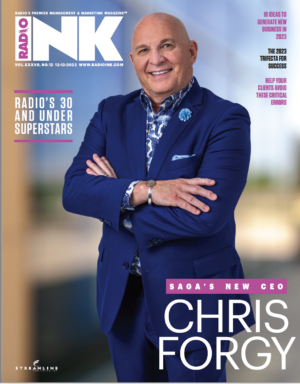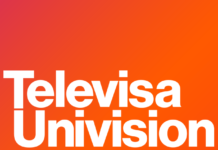
The December 12th issue of Radio Ink magazine starts mailing across the country to subscribers today. The issues includes radio’s 30 and Under Superstars and our cover story interview with new Saga CEO Chris Forgy. Here’s a preview of our interview.
Chris Forgy is ready to take the reins at Saga Communications. He was recently named the new CEO, following the death of Ed Christian in August. And Forgy is ready, for two reasons. First, he’s been working toward a CEO role his entire career. And he’s ready because Christian was training Forgy to be his replacement — though even Forgy didn’t know it.
Saga had had only one CEO in its history, since the company was created in 1986. In December of 2022, Chris Forgy became the second. Here’s how he got to this position and how he plans to lead the company.
Radio Ink: What is your vision for Saga?
Forgy: We use a phrase I brought to the company that says: “Not now, but right now.” Which means, once you have a vision, have verbalized it, and have the acceptance and the buy-in of the people, act right now! We are hyperlocal in all our markets. It’s more important now than ever.
Then Ed Christian, a 30-plus-year CEO and founder of our company, passes away.
Some would expect the leadership team and the people in our markets to be run-
ning in the streets, shouting, “OMG, what are we going to do? Our leader is gone!”
There was none of that. The culture was built on a rock-solid foundation. They know how to behave. If anything, there was a renewed sense of purpose to finish what was unfinished, which is to serve the community we are in with great local content, produce creative, well-produced commercials, build effective advertising schedules, hire great talent, train and support our people, give them direct feedback, build them up, and finally, deliver a healthy value to our stockholders.
The core business and culture of Saga will continue to be Saga. It won’t be exactly how Ed did it, because we must grow and change. We’ve already set in place a few initiatives. One will expand our digital footprint and find other third party resources we could bring in-house that would be consistent with our core business, which, by the way, is what I call our controllables.
We build our business on three areas: local direct, NTR, and digital. Those are our core revenue streams. Anything that would feed into those three silos are the things we will continue to make bigger and better, more efficient and effective. I don’t believe, in the past, we’ve put enough emphasis on what we do from a national perspective. We have two really great national sales managers, Tom Howe and Bruce Werner, and a strong partner in Katz. We put less of an emphasis on that because we felt we couldn’t control it
— when we can impact it. If you take our net revenue from our national revenue and compare it to our individual markets’ revenue, it would be one of Saga’s top three revenue-generating markets. So it needs more emphasis.
Radio Ink: You mentioned “hyperlocal.” What does that mean?
Forgy: We’ve pretty much lost the music battle. I just saw that not only Tesla but
one of the new Ford trucks will have no AM radio. We have 35 AM stations that do
well in their markets. The primary reason that keeps listeners with radio is connec-
tivity. They want to feel connected. They can get music on demand with smart speakers, etc. What is important about the local piece is, when Saga was built, it was built on a
couple of principles. People wonder why we are in the markets we are in. Yankton is one of our largest cash flow markets in terms of percentage of revenue to cash flow. WNAX in Yankton just celebrated 100 years on the air. It has the largest land-mass signal in the U.S. Yet most don’t know what state Yankton is in — South Dakota. In terms of acquisitions, Saga was built this way: we want to be in college towns, state capitals, where there are non-closable military bases, agricultural income, and, more recently, high-net-worth retirement communities.
The other piece is that we are in 27 markets. Twenty-one of those are smaller than market 100. That’s where we are somewhat insulated from countervailing forces that you see in some of the larger markets. We can impact those markets because of what we do and how we behave. We say to our managers, “You should be able to run for mayor should
you be called on because you are that connected.” We deal directly with businesses and decisionmakers in the market. As I said, we have multiple customers. Our listeners, our advertisers, our community, our shareholders, and finally our employees. We treat our people fairly. We provide them the resources and facilities that people in the community want to be a part of. All those elements go into how and why we are local. From a competitive standpoint, our competitors are not investing in being local. Instead, they are
retreating from it.
Radio Ink: Why is it that a good portion of the industry has given up on live and local?
Forgy: Debt. Saga is the healthiest broadcast company in existence from a cash on hand and debt standpoint. Partially because we are not in L.A., New York, etc., by design. As a result, we can actually have an impact on the markets we operate in. We are the market leader in all categories of business. At the same time, our competitors are cutting back on
resources out of necessity.
To subscribe to Radio Ink Magazine in time to read our cover story interview with Forgy and meet radio’s 30 And Under Superstars CLICK HERE.





